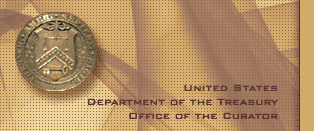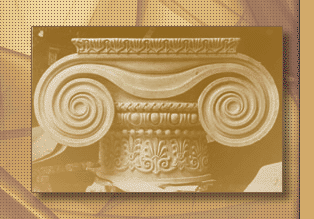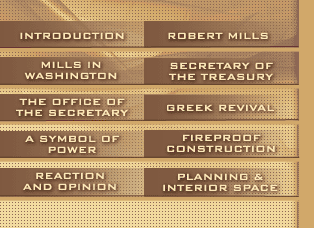“This
style was so early introduced into our country, both on the ground of
economy and correct taste, as it exactly suited the character of our political
institutions and pecuniary means.”
~Robert Mills
In the eyes of many in early nineteenth century Washington, a
deliberate national style would foster a national identity as well as
project an image of order and sophistication to distinguished visitors
from abroad. Many disagreed on what this image should be. Should the new
architecture copy from the past, reinterpret the past, or even be created
into something completely new?
For the new Treasury, the answer was found in the early stages
of the popular movement in America between 1825 to 1855 towards all things
Greek, also called the Greek Revival.
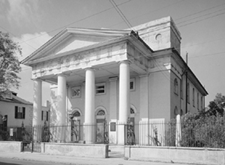
With its clear geometry
and Doric portico, the First Baptist Church, 1818-1822,
Charleston, designed by Robert Mills, demonstrates
a move toward the Greek Revival. Historic American
Buildings Survey.
Click
here to see a more detailed image
Many prominent and outspoken Americans considered that the new
national style lay within an idealized image of the great republics of
classical antiquity through architectural styles derived from ancient
Rome and Greece. Following archaeological discoveries in Greece in the
late 1700’s and early 1800’s, a new interest in Grecian tradition
and aesthetics in particular piqued American interest.
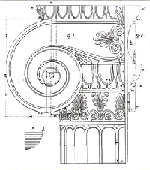
An illustrated pattern book, The beauties of modern
architecture by Minard Lafever, published in 1839,
provided architects with a template for Greek design.
Lafever’s detail of a Greek Ionic capital, seen
right, is similar to the Ionic capitol used by Mills
for Treasury’s 15th Street colonnade. Library
of Congress
To a young America, Greek architecture represented
reason, order, and harmony through its meticulously calculated mathematical
proportions and clarity of design. To Robert Mills, the rational and robust
quality of the Greek Revival was the appropriate solution for the next
generation of federal buildings in Washington, including the Treasury
Building.
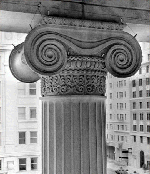
The Greek Ionic Capital,
distinctive in its dip between two scrolled volutes,
crowns the thirty columns along Treasury’s East
facade, adding formality to the exterior in contrast
to the simpler interior column capitals in the Doric
style.
Click
here to see a more detailed image
The Treasury’s powerful austerity derived from a Greek
architectural vocabulary was Mills’ unique interpretation of the
Greek Revival. Its distinctive aesthetic set the standard for the architecture
of government buildings to follow, continuing with the American proclivity
toward the Greek Revival that exceeded well into the twentieth century.
The landscape of government buildings in Washington today resonates the
continuing influence of the Greek Revival and the classical ideals of
a nation seeking to assert its newfound status in the world.
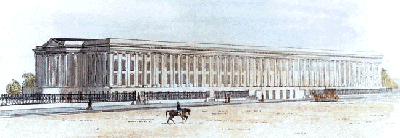
East façade of the Treasury Building,
1850.
Click
here to see a more detailed image
Interested in this topic? More detailed research is available
here
|
